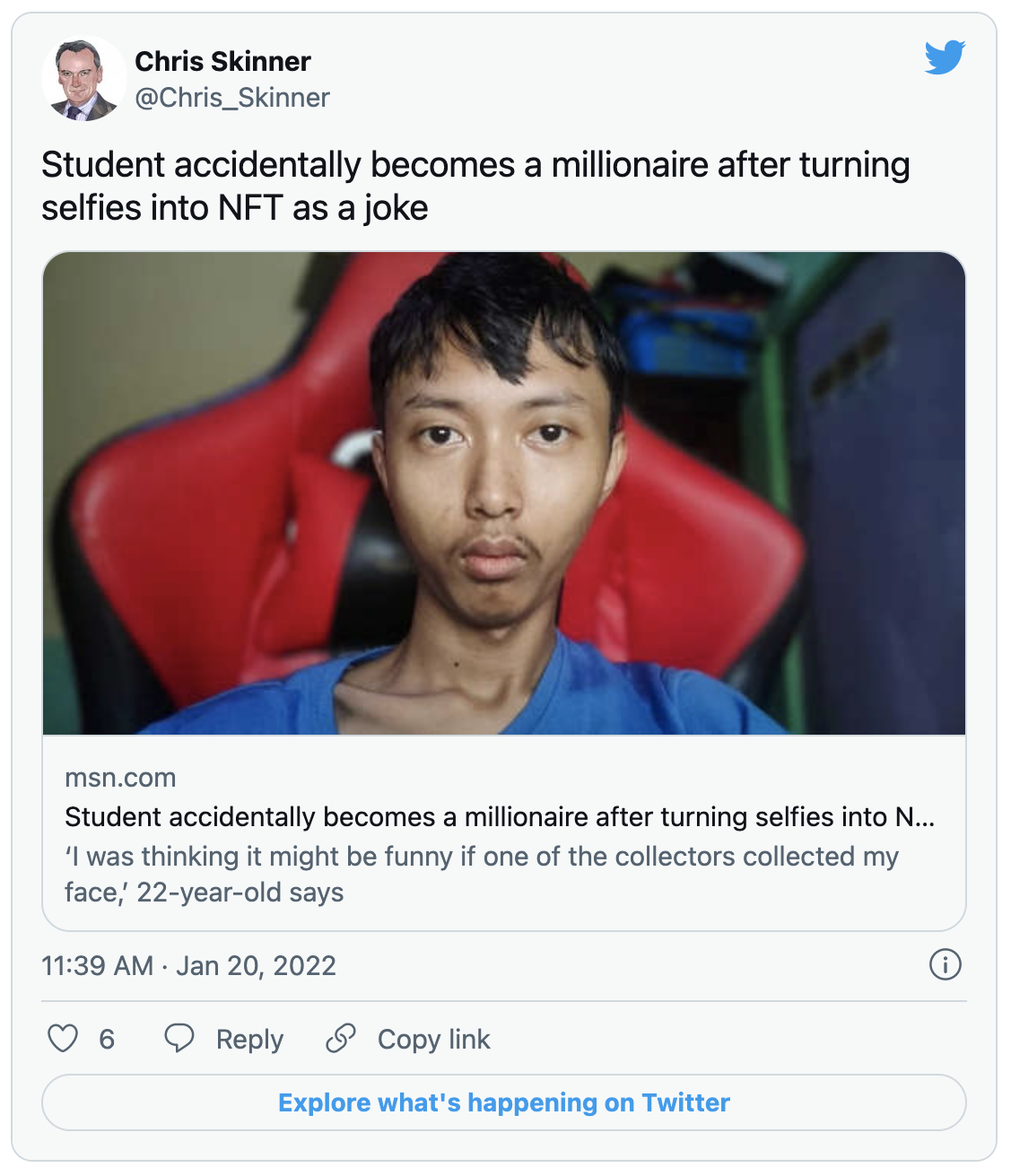Based on this article from the Verge, I thought I’d give my explainer of NFTs.
What does NFT stand for?
NFT stands for Non-Fungible Token, an acronym and phrase that no mere mortal understands.
The gist of it is the word Fungible. Fungible means it can be replaced by something else. I give you a dollar and you give me a kilo of bananas. The bananas are worth a dollar and they can be exchanged easily because they are fungible. They replace each other. $1 is worth 1Kg of bananas. Simples!
But what happens if you own a Picasso painting? I give you 100 million dollars and you give me your Picasso painting. That’s non-fungible because the painting is totally unique. In other words, non-fungible means it cannot be replaced by anything else. You can get more bananas for a dollar, but there’s only one Picasso painting. It is unique.
This is the core reason why NFTs are taking off in art, music, film, entertainment and more because, if you have something unique, you want to secure it as a unique item that can never be replaced. In the olden days, this was done through forms and certificates to provide provenance and history. Today, it is achieved digitally through an NFT.
If you have a token for that Picasso painting, it cannot be replaced by anything except a sale to someone else of that token. That token is unique, as is the painting, and secures its provenance forever.
How do NFTs work?
When you create an NFT, it is registered on a blockchain of which the most widely used today is Ethereum. Once on the blockchain, it registers a unique address that belongs to you. I recently did this using MetaMask and OpenSea. MetaMask generates the blockchain address on Ethereum and OpenSea stores the NFT asset, in this case a digital painting. I can tell you that I didn’t find this easy and so, right now, NFTs are for people who love technology. It’s not for the average John or Jane on the London Omnibus. However, bear in mind that in the 1990s you needed to be a rocket scientist to create a website and yet, today, anyone can. It will get easier.
What’s worth picking up at the NFT supermarket?
A lot of the interest today is in the arts – music, paintings, photographs, poetry, books, ideas, etc – and I watched BBC’s Click this weekend which focused on the subject of NFTs. It was fascinating as it explained that NFT Studios – Building the Metaverse one block at a time – has created a movie studio specifically for the NFT market. The founders are Niels Juul, Leandro Bellone and Nahuel Cirocco. Niels is a lead player, having been Executive Producer of Martin Scorsese’s The Irishman (great film), and they have launched the first NFT funded movie of all time A Wing and A Prayer. Want to own a piece of the movie? Buy an NFT.
As Niels puts it:
“As a producer, my biggest frustration is from the finance side, it is an ordeal. The studios are mainly doing big franchise films, an independent film can take years and years. It’s hard getting investors for films and productions, especially at the development stage, with the Hollywood system. We want to democratise it.”
That sums up NFTs beautifully. Art is hard to fund so let’s crowdfund it.
The thing is, right now, there’s a lot of frivolity around NFTs and people investing unwisely. The people doing that are most likely the people who bought crypto in the early 2010s, which means they’re rolling in it and don’t care what they spend. A good example of the frivolity is this one:

These developments possibly cloud the market for NFTs as it makes it sound stupid. It’s not stupid. It’s an evolving means of creating a new way to deal with digital creativity.
Do people really think this will become like art collecting?
Possibly. I personally collect a lot of rare art, books, comics and autographs, and the issue with all of them is: (a) is it an original and not a replica; and (b) can you prove it? It can be hard, but I tend to keep all packaging and certificates with everything I buy, so it has its provenance held intact. With NFTs, I won’t have to do that, but I have a bigger question: in 300 years, will anyone be able to read my NFT? The issue here is that, like with art from the 1700s and 1800s, if something is sold many times, can you find the complete history and prove its provenance. This is the subject of a BBC show called Fake or Fortune, and I’m pretty sure in one or two centuries we won’t only find NFTs cannot be tracked and traced, but we won’t even have the technology to read them. So, this could just be yet another fad?
I’m going to leave it there, as The Verge goes into humour mode after that last question, but NFTs are really about securing ownership digitally of a unique asset. It does not have to be art – you could make NFTs of diamonds, rare wines and more – but it’s all about having a token that is unique linked to an asset that is unique, whether that asset is physical or digital, which cannot be exchanged without a clear sale on the blockchain.
That’s my view anyhow.


